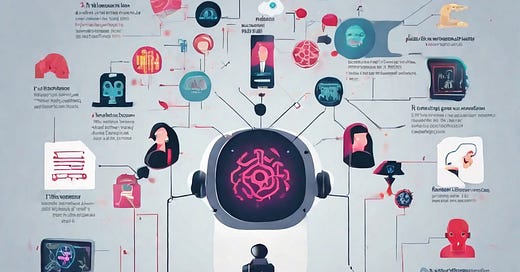Created by StableDiffusionXL
A recent survey of 2,800 business leaders by Aon (here) ranked AI as only the 49th biggest threat for businesses, far below risks like cyber-attacks, business interruption, and economic conditions.
Aon, founded in Chicago in 1982, is a giant insurance company offering commercial risk solutions, reinsurance, retirement and health-related insurance products, and data and analytic services. It has approximately 50,000 employees. Among global insurance providers, Aon is ranked second by way of revenues (2020 data) (Marsh McLennan is ranked first) with mostly large enterprise customers.
The top 10 “current risks” in Aon survey were listed as follows:
Cyber Attack or Data Breach
Business Interruption
Economic Slowdown or Slow Recovery
Failure to Attract or Retain Top Talent
Regulatory or Legislative Changes
Supply Chain or Distribution Failure
Commodity Price Risk or Scarcity of Materials
Damage to Reputation or Brand
Failure to Innovate or Meet Customer Needs
Increasing Competition
The reason these surveyed executives may not view AI as an imminent concern is they are focused on more prominent near-term risks like those emerging from the Covid pandemic and current macroeconomic environment. Many also likely associate AI risk with futuristic scenarios like super-intelligent AI taking over – as in “The Terminator” movies or “WarGames” the movie – not the real-world AI applications being deployed now.
However, AI arguably poses under-appreciated risks potentially embedded within many of the threats they do recognize. AI is increasingly leveraged in cyber-attacks and data breaches. In financial institutions, a new found and extensive fraud threat is synthetic identify fraud or SIF. This new form of fraud has emerged as an innovation created by AI tools. All these embedded AI threats can disrupt business models, introduce data bias and create other ethical challenges. And while some hype has faded, AI continues advancing rapidly.
The survey possibly reflects the detachment of senior executives from on-the-ground-floor where technology changes occur. Or they represent industries yet to feel the impact of AI. Nonetheless, the dismissive view of AI risks contrasts with warnings from tech experts and researchers about the technology's dual-use nature, the limitations of today's AI safety practices and the absence of regulation.
One of thing: This survey was probably done many months ago. The geopolitical volatility in Eastern Europe, Asia and the Middle East should result in geopolitical risk in the top 10.
This survey appears fundamentally flawed, likely devised primarily as a lead generation tactic targeting executives rather than obtaining meaningful, real-time insights. The focus on risks detached from real-time technological changes suggest Aon lacks sufficient understanding of and engagement with clients' current business environments. While lead generation has merit, over-reliance on superficial surveys versus substantive dialogue risks misaligning sales approaches with customer needs. Aon would benefit from reevaluating assumptions underlying this survey and improving two-way communication channels to develop client relationships based on value, not just access to executives.
But it should be said that while other risks understandably dominate executive mindshare currently, the low ranking of AI threats points to potential blind spots. Business leaders should proactively monitor AI developments, establish internal oversight mechanisms for AI applications and importantly, educate executives, managers and workers on AI – not just react once substantial harm occurs. Greater technical literacy and less complacency around AI risks seem prudent given its increasing ubiquity across the business landscape.




